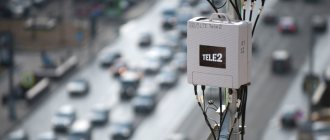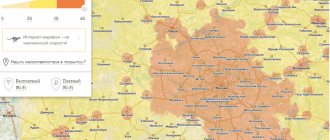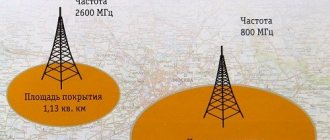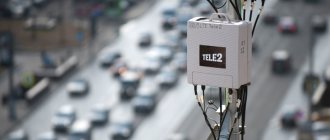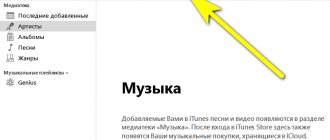Today on the territory of Russia it was built more than 744 thousand cell towers that allow us to use our gadgets, make calls, download music and surf the Internet.
Each tower has its own owner, one of the Big Three operators. Below I have collected data that will certainly help you make a decision: which operator to connect to in the future.
Not only the quality of coverage, but also the speed of data transfer and mobile Internet depends on the number of towers in the assets of each operator.
According to Roskomnadzor, more than 300 thousand cell stations support the most modern communication format: 4G/LTE/LTE Advanced.
All these stations together provide high-speed Internet to more than 90% of all residents in 83 regions of Russia.
Who owns cell towers
The list of operators by the number of their own towers looks like this:
MegaFon - more than 238 thousand cell stations.
MTS – about 184 thousand cellular stations.
T2 Mobile – 167 thousand cellular stations.
Beeline - more than 156 thousand cell stations.
All four operators own a total of about 80% of all towers. The remaining 20% is owned by third-party organizations, such as Russian Tower and Vertical. These towers are rented to operators for relatively little money, from 15 to 30 thousand rubles per month.
The most advanced operator is MegaFon, which has the most stations, which means the widest network coverage in Russia. Roskomnadzor data also confirms MegaFon's leadership in the number of LTE base stations.
Cell tower close up.
To provide good coverage and high speeds of mobile Internet, operators have to build base stations in a variety of locations.
For example, what MegaFon towers look like in the most remote places:
The towers are installed in the city of Verkhoyansk and the village of Tomtor, in the Republic of Sakha Yakutia, where the temperature drops to -68 degrees.
The cellular station was built 500 meters from the launch field of the Vostochny cosmodrome in the Amur region
The base stations in the Sochi Olympic Park are disguised as palm trees so as not to be conspicuous.
A cell station on the Kola Peninsula is needed for drivers, because there are no cities nearby. Powered by a wind generator.
A cell tower in the rotational village of Sabetta on the Yamal Peninsula, which allows you to post a photo on Insta literally from the ends of the earth.
Network coverage maps were found on the website Speedtest.net. The list of operators is arranged in this order:
1. MegaFon 2. MTS 3. Beeline 4. Tele2
MegaFon has the densest coverage, followed by MTS, which has less dense coverage in the Southern Federal District. Next comes Beeline, and in last place is Tele2.
Details about the coverage area and its features
To begin with, we note that the most accurate map of Rostelecom’s coverage area in Russia does not exist. Even the operator himself does not have it. The thing is that when constructing maps, the features of the terrain and the presence of certain buildings in it that absorb or reflect the signal are not taken into account. Also, in the process of creating maps, the nature of the propagation of radio waves is not taken into account.
Creating an accurate map even taking these parameters into account is impossible for two reasons. The first is that the location of objects on the ground may change. Secondly, the propagation of radio signals is influenced by dozens of factors: air humidity and temperature, precipitation, solar activity, the earth’s magnetic field and much more. Therefore, absolutely all coverage maps are indicative only.
Determining on your own what Rostelecom’s coverage area looks like is even more difficult. First, the cell phone does not display the received signal strength data in real time. And secondly, phones differ from each other in sensitivity. One will show the presence of a signal at a given point, the other will declare its absence. A practical experiment will help clarify the adequacy of the reception:
- Buy a Rostelecom SIM card.
- You leave for the place.
- You take your phone out of your pocket.
- Check for the presence of a signal.
But even in this case, you can’t count on a 100% result - due to the peculiarities of radio signal propagation, next time there may not be coverage at a given point.
What are the forecasts for the future?
In anticipation of the emergence of new 5G networks with increased capacity, all operators are preparing to modify their base stations.
MegaFon and Beeline actively cooperate with Huawei, the main supplier of 5G equipment around the world.
MTS works with Ericsson, and Tele2 works with Nokia.
Back in 2021, all operators successfully conducted tests related to preparing for the introduction of 5G. Moreover, MegaFon showed the best results: the speed of data reception using the new technology in the networks of this operator reached 35 Gbit .
Topic: What kind of MegaFon Fastest appeared in the network status bar
MTS, together with Ericsson, showed the maximum speed on test equipment in the region of 25 Gbit .
Beeline, despite its partnership with Huawei, reported speeds of more than 1 Gbit/sec .
Considering all the facts, MegaFon will be the first to launch 5G in Russia . This is facilitated by the largest number of base stations and cooperation with Huawei.
The arrival of the next generation cellular network is only a matter of time. The operators are already ready for it.
( 42 votes, overall rating: 4.38 out of 5)


